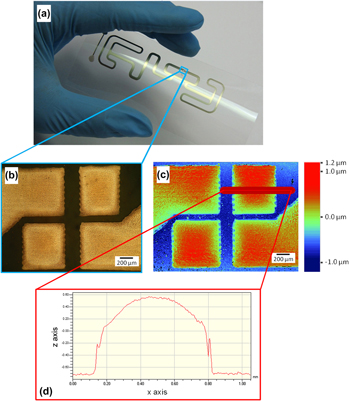Crossref Citations
This article has been cited by the following publications. This list is generated based on data provided by
Crossref.
Kamyshny, Alexander
and
Magdassi, Shlomo
2013.
Kirk-Othmer Encyclopedia of Chemical Technology.
p.
1.
Pabst, Oliver
Perelaer, Jolke
Beckert, Erik
Schubert, Ulrich S.
Eberhardt, Ramona
and
Tünnermann, Andreas
2013.
All inkjet-printed piezoelectric polymer actuators: Characterization and applications for micropumps in lab-on-a-chip systems.
Organic Electronics,
Vol. 14,
Issue. 12,
p.
3423.
Adner, David
Wolf, Franziska M.
Möckel, Stefan
Perelaer, Jolke
Schubert, Ulrich S.
and
Lang, Heinrich
2014.
Copper(II) ethylene glycol carboxylates as precursors for inkjet printing of conductive copper patterns.
Thin Solid Films,
Vol. 565,
Issue. ,
p.
143.
Kamyshny, Alexander
and
Magdassi, Shlomo
2014.
Conductive Nanomaterials for Printed Electronics.
Small,
Vol. 10,
Issue. 17,
p.
3515.
Fu, Ji Lan
Li, Ya Ling
Mo, Li Xin
Wang, Yu
Ran, Jun
Pang, Zhe
Ma, Yan
and
Li, Lu Hai
2014.
Preparation of Conductive Nanosilver Ink and its Application on RFID Tags.
Advanced Materials Research,
Vol. 904,
Issue. ,
p.
121.
Jeong, Jin-A
Kim, Han-Ki
and
Kim, Jihoon
2014.
Invisible Ag grid embedded with ITO nanoparticle layer as a transparent hybrid electrode.
Solar Energy Materials and Solar Cells,
Vol. 125,
Issue. ,
p.
113.
Yoo, Ji Hoon
Han, Dae Sang
Park, Su Bin
Chae, Jangwoo
Kim, Ji Man
and
Kwak, Jeonghun
2014.
Fast and low-temperature sintering of silver complex using oximes as a potential reducing agent for solution-processible, highly conductive electrodes.
Nanotechnology,
Vol. 25,
Issue. 46,
p.
465706.
Wünscher, Sebastian
Abbel, Robert
Perelaer, Jolke
and
Schubert, Ulrich S.
2014.
Progress of alternative sintering approaches of inkjet-printed metal inks and their application for manufacturing of flexible electronic devices.
J. Mater. Chem. C,
Vol. 2,
Issue. 48,
p.
10232.
Park, Janghoon
Kang, Hyi Jae
Shin, Kee-Hyun
and
Kang, Hyunkyoo
2016.
Fast sintering of silver nanoparticle and flake layers by infrared module assistance in large area roll-to-roll gravure printing system.
Scientific Reports,
Vol. 6,
Issue. 1,
Liu, Liang
Ma, Siyuan
Pei, Yunheng
Xiong, Xiao
Sivakumar, Preeth
and
Singler, Timothy J.
2016.
Regulation of the Deposition Morphology of Inkjet-Printed Crystalline Materials via Polydopamine Functional Coatings for Highly Uniform and Electrically Conductive Patterns.
ACS Applied Materials & Interfaces,
Vol. 8,
Issue. 33,
p.
21750.
Mattana, Giorgio
Loi, Alberto
Woytasik, Marion
Barbaro, Massimo
Noël, Vincent
and
Piro, Benoît
2017.
Inkjet‐Printing: A New Fabrication Technology for Organic Transistors.
Advanced Materials Technologies,
Vol. 2,
Issue. 10,
Kamyshny, Alexander
and
Magdassi, Shlomo
2017.
Nanomaterials for 2D and 3D Printing.
p.
119.
Wu, Wei
2017.
Inorganic nanomaterials for printed electronics: a review.
Nanoscale,
Vol. 9,
Issue. 22,
p.
7342.
Tsumaki, Masanao
Nitta, Kaishu
Jeon, Suyeon
Terashima, Kazuo
and
Ito, Tsuyohito
2018.
Development of plasma-assisted inkjet printing and demonstration for direct printing of conductive silver line.
Journal of Physics D: Applied Physics,
Vol. 51,
Issue. 30,
p.
30LT01.
Bobinger, Marco
Haider, Michael
Goliya, Yash
Albrecht, Andreas
Becherer, Markus
Lugli, Paolo
Rivadeneyra, Almudena
and
Russer, Johannes
2018.
On the sintering of solution-based silver nanoparticle thin-films for sprayed and flexible antennas.
Nanotechnology,
Vol. 29,
Issue. 48,
p.
485701.
Balliu, Enkeleda
Andersson, Henrik
Engholm, Magnus
Öhlund, Thomas
Nilsson, Hans-Erik
and
Olin, Håkan
2018.
Selective laser sintering of inkjet-printed silver nanoparticle inks on paper substrates to achieve highly conductive patterns.
Scientific Reports,
Vol. 8,
Issue. 1,
Raut, N. C.
and
Al-Shamery, K.
2018.
Inkjet printing metals on flexible materials for plastic and paper electronics.
Journal of Materials Chemistry C,
Vol. 6,
Issue. 7,
p.
1618.
Hermerschmidt, Felix
Burmeister, David
Ligorio, Giovanni
Pozov, Sergey M.
Ward, Richard
Choulis, Stelios A.
and
List‐Kratochvil, Emil J. W.
2018.
Truly Low Temperature Sintering of Printed Copper Ink Using Formic Acid.
Advanced Materials Technologies,
Vol. 3,
Issue. 12,
Kamyshny, Alexander
and
Magdassi, Shlomo
2019.
Conductive nanomaterials for 2D and 3D printed flexible electronics.
Chemical Society Reviews,
Vol. 48,
Issue. 6,
p.
1712.
Mo, Lixin
Guo, Zhenxin
Yang, Li
Zhang, Qingqing
Fang, Yi
Xin, Zhiqing
Chen, Zheng
Hu, Kun
Han, Lu
and
Li, Luhai
2019.
Silver Nanoparticles Based Ink with Moderate Sintering in Flexible and Printed Electronics.
International Journal of Molecular Sciences,
Vol. 20,
Issue. 9,
p.
2124.
